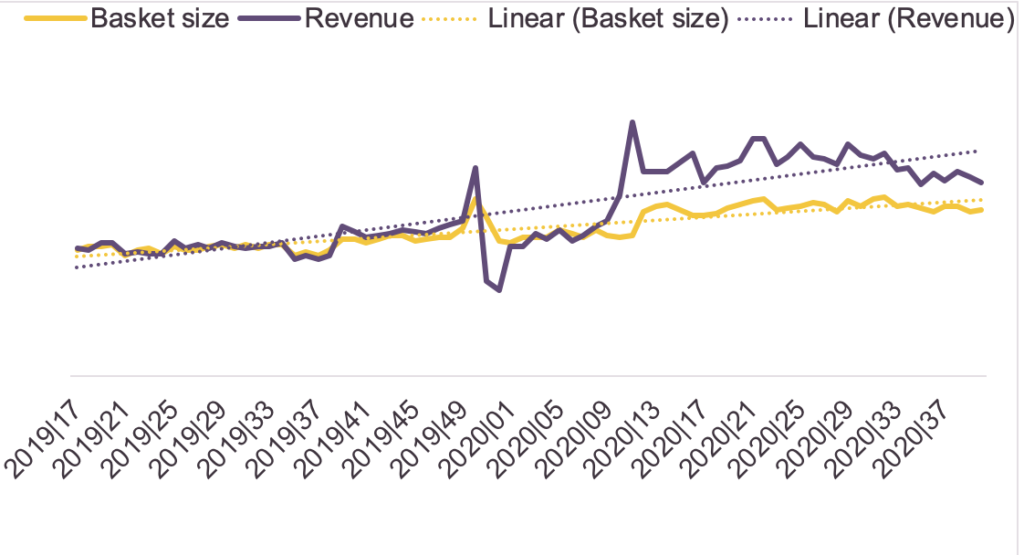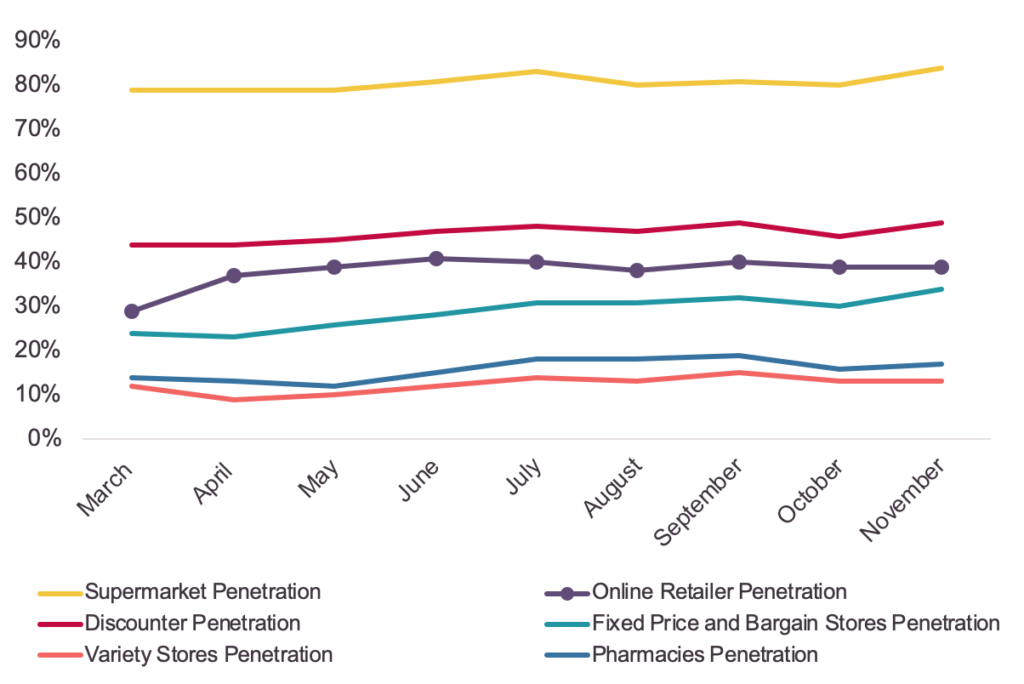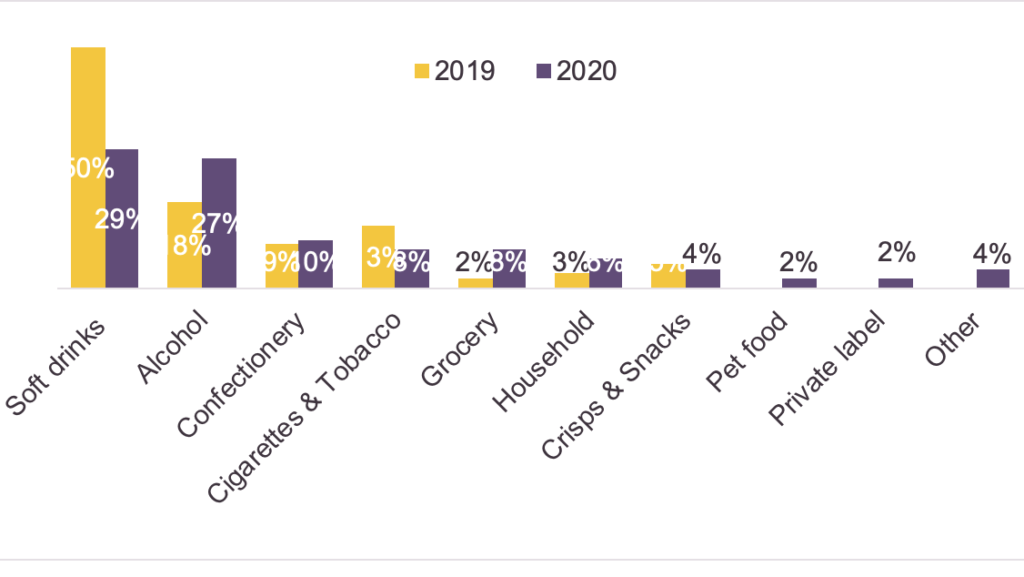The coronavirus outbreak has brought an unprecedented shift to the wholesale market, with performance in the retail and foodservice channels polarised, says Lumina Intelligence insights manager Ellen Codd.
Wholesalers have dealt with significant logistical and stock challenges throughout 2020. On the retail side, wholesalers have been faced with huge demand surges throughout the year to keep depots and shops stocked, while also introducing and adhering to government approved safety measures. As risk averse and cost-conscious consumers increasingly favour in-home consumption, retail focused wholesalers have experienced increased pressure to keep goods on shelves and to ramp up delivery operations. On the other hand, foodservice wholesalers have seen customers closed for long periods throughout 2020, with some closing indefinitely, and have needed to relocate perishable stock.
The convenience retail market is expected to grow by 8% to £44.7bn in 2020, while the Eating Out market is set to decline by over 40% in 2020. Similarly, while 63% of Grocery Retail professionals report positive trading conditions in 2020 a huge 97% of Eating Out market professionals report a challenging 2020.
Analysis: What is the future of B2C within foodservice?
Performance of top players in the wholesale market has depended greatly on proximity to foodservice, with the impact of the outbreak and subsequent lockdowns varying between company sub-category and company full year end. While the turnover growth for the top nine wholesalers is estimated at +2.8%, this varies from -39.1% decline at foodservice focused Brakes, while hybrid player Morrisons reports 16.0% growth.
Whilst future prospects are also split across channels, the coronavirus has forced innovation throughout 2020. Wholesalers have worked to future-proof operations, investing in new technologies and routes to market, while also supporting local communities throughout a difficult year.
1. The Digital Evolution
Over the past decade, retailers have embraced the delivered channel, with 96% of retailers using the delivered channel as their primary route to market in 2019, increasing from 24% in 2008. This has been further accelerated by the coronavirus outbreak and will be a key area of investment going forward.
As consumers shift to shopping locally and depending increasingly on their local convenience stores, convenience retailers are placing more frequent, larger orders to keep shelves stocked to serve the local community. Following an initial spike in March, average basket size and value have remained above 2019 levels.
 This trend is likely to continue post-coronavirus, and further emphasises the need for optimised wholesaler websites and apps to streamline the ordering experience for time poor retailers. Wholesalers have reacted to this with investment in the delivered channel. Costco, for example, launched an online delivery service for the first time in April 2020, while in June, Nisa released a mobile app to help retailers with a range of business activities, including ordering, price checking, and delivery tracking.
This trend is likely to continue post-coronavirus, and further emphasises the need for optimised wholesaler websites and apps to streamline the ordering experience for time poor retailers. Wholesalers have reacted to this with investment in the delivered channel. Costco, for example, launched an online delivery service for the first time in April 2020, while in June, Nisa released a mobile app to help retailers with a range of business activities, including ordering, price checking, and delivery tracking.
2. Alternative routes to market
Digital investment is not limited to retail wholesale, with foodservice focused wholesalers also increasingly embracing alternative routes to market. While facing closures of customers, wholesalers have begun to diversify operations and explore direct to consumer trading as a means of offsetting losses. Brakes launched its ‘Food Shop’ service in March 2020, allowing shoppers to browse the wholesaler’s website and phone in orders for collection the following day. With consumers facing difficulty securing delivery slots from supermarkets, wholesalers have seen growing interest in direct to consumer services. JJ Foodservice responded to demand through investment in smaller delivery vans to negotiate tighter London streets, and more recently launched a ‘Christmas at Home Essentials range’ for consumers.
The direct to consumer RTM is a growing opportunity for wholesalers, as penetration of the online retail channel has remained high throughout the year and consumers demand for grocery retail outweighs supply at key times of the year, including the upcoming Christmas period. Throughout lockdown, delivered grocery has become ubiquitous and has broken the generational barrier, with older consumers also embracing newer technologies.

3. Category Focus
During the first nationwide lockdown in March, consumers faced empty shelves in supermarkets as stockpiling behaviour set in, while convenience retailers adapted ranges to cater to changing consumer behaviours. Retail wholesale sites saw increased searches for grocery products, accounting for 8% of the top 100 search terms in 2020, in comparison to 2% prior to the coronavirus outbreak. The grocery category also saw an uplift in revenue terms throughout the year, while consumers also increasingly embraced the frozen category. This has been identified as an area for future investment by grocery retail professionals in the Lumina Intelligence Top of Mind report, as “Consumers reappraised the frozen category and were pleasantly surprised by the choice, convenience and value”.
The alcohol category has also seen an uplift in retail-focused wholesale. Hospitality closures and restrictions throughout the year have seen consumers switch to at-home consumption, underlining an increasing opportunity for more premium ranges in the category as consumers try to recreate the pub experience at home.

4. Community Involvement
While convenience retailers work to support their local communities during a difficult year, wholesalers are also acting to support their customers and communities, offering food and grocery delivery services and engaging in charity outreach. With almost 5,000 wholesale staff having been made redundant as a result of the coronavirus, a new industry jobs board was launched in November to make it easier for job seekers to find jobs within the industry. Brakes, along with leading retailers and food manufacturers, joined the Child Food Poverty Task Force formed by footballer Marcus Rashford.








